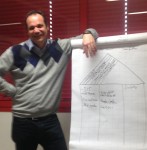The amazing challenging power of TPS
Toyota’s Thinking People System continues to amaze me.
To prepare for tomorrow’s gemba visit of one of their sites, the CEO and COO of this service company used the TPS House to draw the list of challenges they needed to tackle.

- COMPETITIVE EDGE: What is the competitive challenge of this site: How is the competition in this particular region? How does it differ from other regions? Where should the site outperform its competitors to find growth?
- CUSTOMER SATISFACTION: What is our main customer satisfaction challenge? From looking at customer complaints and customer feed-back, what specific issue should be face to add greater value to our local customers?
- PEOPLE DEVELOPMENT: What are the main capability development issues on the site?
- OPERATIONAL CHALLENGES: 1) What is our main safety issue on this site? What is our main quality issue on this site? 3) How can we reduce lead-time on this site? 4) what is our main flexibility problem on this site? 5) What is our main total cost problem on this site? 6) What is our main energy performance here on site? 7) is there a morale issue on site?
- JUST-IN-TIME: What is the take time for this site? What is the biggest block to continuous flow of work? Where are we batching most?
- JIDOKA: What is the principal issue we should learn to see (and call for help) before diving in? What is the next poke-yoke we should work on? Where should we be separating better people’s work from the system’s work?
- HEIJUNKA: What planning issue should we tackle to avoid mura, muri and mud right here on site?
- STANDARD WORK: Which standards should we look at in detail in the way people work here on site?
- KAIZEN: What is kaizen effort are local teams working on we should go and see and listen out?
- BASIC STABILITY: Is the 5S plan happening? Are stable teams stable? Is the safety plan vigorous enough?
Granted, that makes quite a bucket list – but the issue here is NOT to create a checklist for what to see on the gemba. The point of this exercise is drawing a unique understanding of the site and – to the CEO and COO’s surprise – the realization that sure, some issues are company specific, but many challenges are absolutely linked to the regional situation and the personalities of the people on site.
Having finished the full exercise, CEO and COO discussed their resulting model of the site and chose the three main challenges they wanted to discuss with the site manager during the gemba walk, mainly one customer challenge, one operational challenge and one people development challenge.
The point was not to tell the site manager what to do, but ask him how he intended to respond to the challenge and what support he needed from corporate to be able to do so, and then check current state and progress on the gumbo itself.
What they were amazed at, though, is how basing the conversation on the TPS led to a completely different perspective on the site, its management team, and the challenges of the company as a whole. This is the amazing power of using TPS as the basis of lean thinking: making you face your own challenges, by drawing a lean model of your business.
One Comment










Pingback: The amazing challenging power of TPS - Lead Wit...